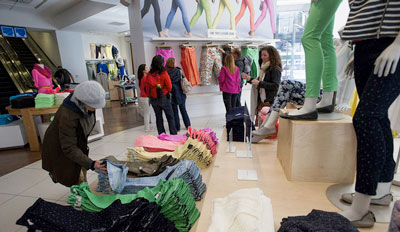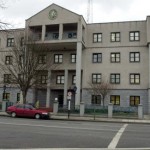American Shoppers Take Breather After March Retail Sales Surge

American consumers took a respite from going to malls and restaurants as retail sales climbed less than forecast in April after the strongest gain in four years.
The 0.1 percent increase followed a revised 1.5 percent surge in March that was the biggest since March 2010, Commerce Department figures showed today in Washington. The median forecast of 83 economists surveyed by Bloomberg called for a 0.4 percent advance.
Consumers were less inclined to ramp up again after March saw a release of pent-up demand caused by harsh winter weather. At the same time, a pickup in hiring, rising home values and higher April sales at retailers from Gap Inc. (GPS) to Cato Corp. (CATO) signal household spending, which makes up about 70 percent of the economy, is poised to resume growth.
“There may have been some pullback after the strong rebound in March,” Russell Price, senior economist at Ameriprise Financial Inc. in Detroit, said before the report. Price is the top forecaster of retail sales over the past two years, according to data compiled by Bloomberg. “I want to see consumer spending back at a healthy run rate after month-to-month fluctuations and we’ll get there shortly. Job growth, household wealth gains and improving confidence are going to coalesce in stronger spending in coming months.”
Stock-index futures trimmed earlier gains after the report. The contract on the Standard & Poor’s 500 Index maturing in June rose 0.1 percent to 1,894.6 at 8:34 a.m. in New York following record levels for equity benchmarks yesterday.
Estimates in the Bloomberg survey ranged from a decline of 0.5 percent to a 0.8 percent gain. The reading for March was previously reported as a 1.2 percent increase.
Import Costs
Another report today showed the cost of goods imported into the U.S. unexpectedly dropped 0.4 percent in April, the first decrease since November, after increasing 0.4 percent the prior month, according to Labor Department data. Over the past 12 month, the import-price index declined 0.3 percent.
Eight of 13 major retail categories showed gains last month, led by clothing stores and sporting-goods outlets, today’s Commerce Department report showed.
A later Easter holiday than last year probably helped boost demand for spring outfits as apparel sales climbed 1.2 percent, the most since October. Receipts also increased at general-merchandise outlets, including a 1.8 percent jump at department stores that was the biggest since January 2013.
Warmer weather and steep discounts also helped to energize shoppers, industry data showed last week. Retailers’ sales at stores open at least a year climbed 6.2 percent in April from a year earlier, the most since June 2011, according to researcher Retail Metrics Inc.
Clothing Stores
Gap, a San Francisco-based apparel retailer, posted a 9 percent advance in April same-store sales while analysts had projected a drop. The results were led by Old Navy, the company’s value-focused brand, while its Banana Republic and namesake Gap chain also reported gains.
Cato, a women’s apparel store-chain, reported an 18 percent surge in April same-store sales, and raised its profit forecast for the first quarter.
Today’s report showed sales rose 0.6 percent at automobile dealers after a 3.6 percent increase the prior month.
Industry figures on May 1 showed vehicle sales cooled after a surge in March that reflected unusually cold and snowy weather in early 2014. Cars and light trucks sold at a 16 million annualized pace in April after a 16.3 million rate in March, according to Ward’s Automotive Group. Those were still the best back-to-back months since September-October of 2007.
“The economy appears to be on an improving trend for the second quarter and the rest of the year,” Emily Kolinski Morris, senior U.S. economist at Dearborn, Michigan-based Ford Motor Co. (F), said on a sales call on May 1. She cited advances in consumer confidence and employment as helping demand.
Excluding Autos
Retail sales excluding autos were unchanged after rising a more-than-previously estimated 1 percent in March, today’s report showed. They were projected to advance 0.6 percent, according to the Bloomberg survey median.
Core sales, which are the figures used to calculate gross domestic product and exclude such things as autos, gasoline stations and building materials, fell 0.1 percent after a 1.3 percent increase in the previous month that was larger than previously estimated. It was the first decrease since January.
Declining demand at restaurants, electronic and furniture stores paced the setback.
Job gains are helping to sustain household purchases. Payrolls rose by 288,000 in April, the biggest increase in two years, while the jobless rate fell to 6.3 percent, the lowest since September 2008, according to a Labor Department report released on May 2.
Home Prices
Property values in 20 U.S. cities increased 12.9 percent in February from the same month in 2013 after a 13.2 percent gain in the year ended in January, according to an index from S&P/Case-Shiller on April 29.
The improvement in the labor and housing markets is lifting sentiment. Consumer confidence for the week ended May 4 held near the second-highest level in more than six years as households remained upbeat about their finances, a report on the Bloomberg Consumer Comfort Index (COMFCOMF) showed.
At the same time, the economy still requires a strong dose of stimulus five years after the recession ended, because unemployment and inflation are well short of the Fed’s goals, according to Federal Reserve Chair Janet Yellen.
“While conditions in the labor market have improved appreciably, they are still far from satisfactory,” she said in testimony to lawmakers last week.
Source: bloomberg





























